
How to Get More Sales with Amazon Posts
Table of Contents
Amazon Posts offers sellers a powerful yet underutilised opportunity to drive more sales. If you’re looking to boost your Amazon business beyond traditional PPC and SEO tactics, Posts might be your secret weapon. With sellers reporting up to 72.6% more branded searches and 2.5% higher purchase rates, this social media-like feature deserves your attention—particularly if your competitors haven’t caught on yet.
Understanding Amazon Posts Fundamentals
Amazon Posts is essentially a social media feed built directly into the Amazon shopping experience. It allows brand-registered sellers to share lifestyle images, product highlights, and brand stories that appear across multiple placements on Amazon. Unlike standard product listings or Sponsored Brands, Posts creates a discovery-focused shopping experience that catches buyers when they’re actively browsing similar products.
Posts appear in five key locations:
- On your brand’s profile page
- On product detail pages within your brand catalogue
- On related product detail pages (including competitors')
- In category-based feeds that shoppers can browse
- In the Posts feed accessible through the Amazon mobile app
To be eligible for Amazon Posts, you must:
- Be enrolled in Amazon Brand Registry
- Have an active Seller Central or Vendor Central account in good standing
- Sell products in eligible categories (most major categories qualify)
- Have your brand’s store page set up
What makes Posts particularly valuable is that, unlike Amazon Advertising, it’s completely free to use. You’re essentially getting premium placement across Amazon without paying a penny in ad spend.
Setting Up Your Amazon Posts Strategy
Before diving into creating individual Posts, you need a coherent strategy that aligns with your overall business goals.
Creating a Posts Content Calendar
Rather than posting randomly, develop a structured content calendar that covers:
- Regular posting cadence (2-3 times per week is often optimal)
- Seasonal themes and promotions
- Product launch announcements
- Content themes that resonate with your target audience
Your calendar should balance promotional content with lifestyle imagery and educational Posts. A good rule of thumb is the 70/30 split—70% lifestyle/educational and 30% directly promotional.
Aligning Posts with Your Product Strategy
Your Posts strategy shouldn’t exist in isolation. Consider:
- Which products need visibility boosts?
- What items have the highest margins?
- Which products convert well but suffer from low traffic?
- What seasonal items need promotion?
Use Posts to strategically drive traffic to these priority products, rather than simply promoting your bestsellers that already enjoy good visibility.
Creating High-Converting Amazon Posts
The difference between Posts that drive sales and those that simply exist comes down to execution quality.
Step-by-Step Guide to Creating Your First Post
- Log into Seller Central and navigate to the Posts dashboard
- Click “Create Post”
- Upload your image (1080 x 1080 pixels works best)
- Write your caption (up to 2,200 characters)
- Tag relevant products from your catalogue
- Preview your Post
- Publish or schedule for later
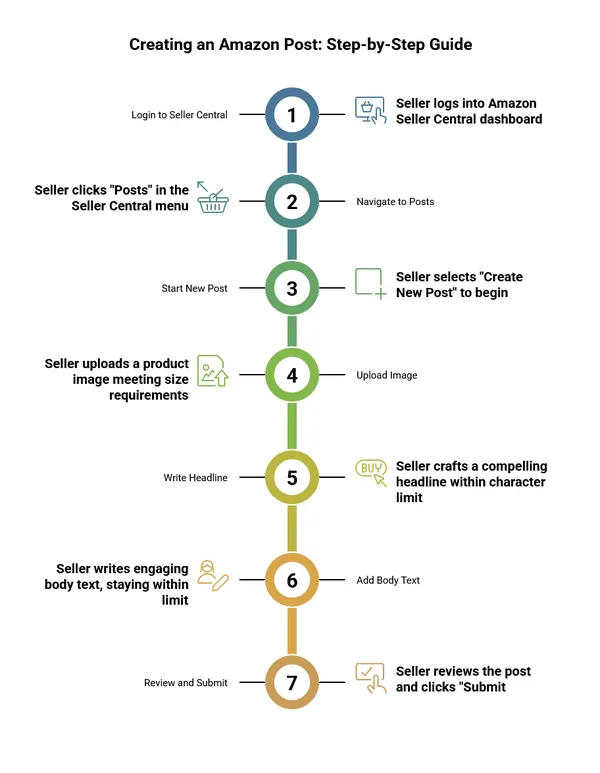
Image Selection and Optimization Strategies
Your images are the most critical element of successful Posts. Unlike standard product photography, Posts images should:
- Show products in use (lifestyle imagery)
- Feature real people using your products
- Highlight multiple products in a single image when relevant
- Maintain consistent brand aesthetics
- Avoid text overlays (Amazon often rejects these)
- Use natural lighting where possible
The most successful Posts typically feature high-quality lifestyle imagery that helps shoppers envision using your products in their own lives.
Writing Compelling Captions That Drive Action
Your caption needs to accomplish several things simultaneously:
- Grab attention in the first line
- Explain the benefit of the product
- Create desire through storytelling
- Include a clear call-to-action
- Naturally incorporate relevant keywords
Here’s a formula that works well:
- Start with a hook (question, surprising fact, or relatable problem)
- Explain how your product solves this problem
- Include a specific benefit
- End with a soft call-to-action
For example: “Tired of charging your phone multiple times a day? Our PowerMax battery case doubles your iPhone’s battery life while adding minimal bulk. Perfect for travellers and busy professionals who can’t afford to be tethered to a wall socket. Tap to discover how it can keep you powered all day.”
Visibility Optimization Strategies
Creating great Posts is only half the battle—you need to ensure they’re seen by potential customers.
Keyword Integration Techniques
While Amazon hasn’t explicitly confirmed that Posts are keyword-searchable, evidence suggests that strategic keyword inclusion improves visibility:
- Include primary keywords naturally in your captions
- Use variations of keywords rather than exact repetition
- Incorporate category-specific terminology
- Mention common use cases and problems your product solves
The key is subtlety—your caption should read naturally while incorporating relevant search terms.
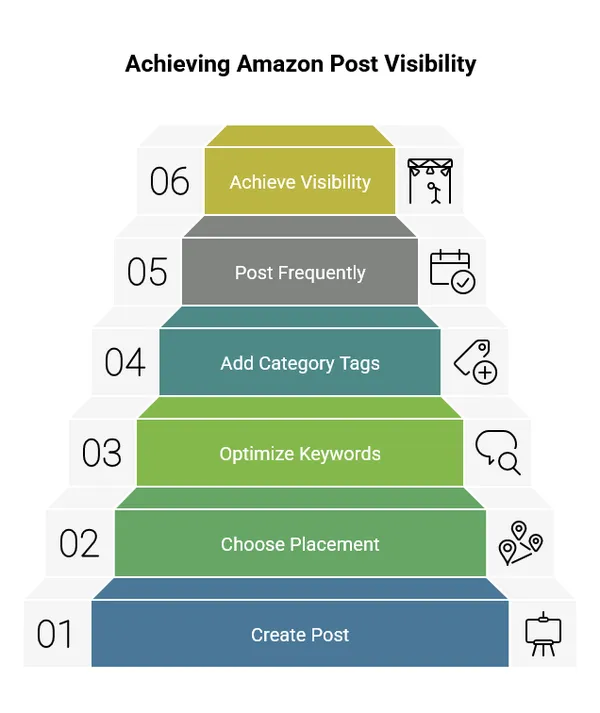
Category Tagging Strategies
When creating Posts, you’ll tag products from your catalogue. This product selection affects where your Posts appear:
- Tag products from the same category to strengthen category relevance
- Tag products that complement each other to encourage multiple purchases
- For Posts appearing on competitor pages, tag products most similar to theirs
- Experiment with tagging both bestsellers and newer products needing exposure
A strategic approach is to create separate Posts for different product categories rather than trying to promote your entire catalogue in one Post.
Posting Frequency and Timing
Consistency trumps volume when it comes to Posts. Research suggests:
- 2-3 Posts per week is the sweet spot for most brands
- Posting during peak shopping hours (7-10pm weekdays, 10am-2pm weekends) may increase visibility
- Maintaining a regular cadence is more important than perfect timing
- Increasing frequency during peak selling seasons (Q4 for most categories)
Remember that Posts remain visible for up to 90 days, so even a modest posting schedule builds up a substantial presence over time.
A/B Testing Framework for Amazon Posts
The brands seeing the greatest success with Amazon Posts implement systematic testing rather than guessing what works.
What Elements to Test
Focus your testing efforts on these high-impact elements:
- Image style (lifestyle vs. product-focused)
- Caption length (short vs. detailed)
- Call-to-action phrasing
- Number of products tagged
- Image composition (single product vs. multiple products)
- Caption tone (educational vs. promotional)
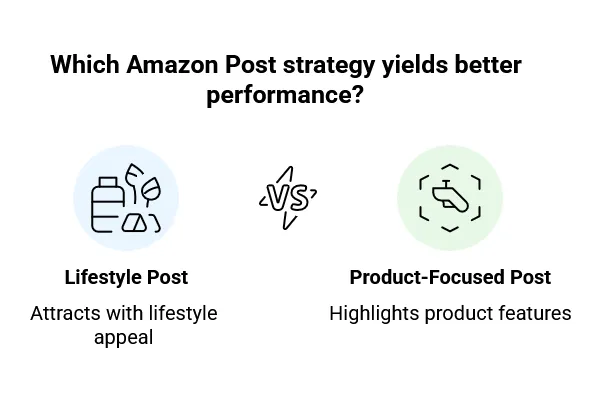
Setting Up Controlled Tests
To run effective A/B tests:
- Change only one variable at a time
- Keep all other elements identical
- Run tests for at least 14 days to gather sufficient data
- Track key metrics (impressions, clicks, click-through rate, sales)
- Document your findings systematically
A simple spreadsheet tracking each test variable and the resulting performance metrics will help you identify patterns over time.
Advanced Post Performance Analytics
Amazon provides basic metrics for Posts, but savvy sellers go beyond these surface-level insights.
Understanding Amazon Posts Metrics Dashboard
The native Posts dashboard shows:
- Impressions (how many times your Post was viewed)
- Clicks (how many times shoppers tapped on your Post)
- Click-through rate (percentage of impressions that resulted in clicks)
- Products clicked (which tagged products received attention)
While useful, these metrics don’t directly show sales impact—that requires additional tracking.
Setting Up Custom Tracking for Sales Attribution
To connect Posts activity with actual sales:
- Create unique tracking links for products featured in Posts
- Use Amazon Attribution if you’re driving traffic from external sources to your Posts
- Compare sales velocity before and after Posts campaigns
- Track branded search volume increases that correlate with Posts activity
- Monitor changes in organic ranking for products featured in Posts
Calculating ROI from Your Posts Strategy
Even though Posts are free, they still require time and resources to create. Calculate your ROI by:
- Estimating the time cost of creating and managing Posts
- Tracking incremental sales attributable to Posts activity
- Comparing the efficiency of Posts vs. paid advertising channels
- Factoring in the long-term brand awareness benefits
Most sellers find that Posts deliver exceptional ROI compared to paid channels, particularly for brand-building and discovery.
Integration with Multi-Channel Marketing
The most sophisticated Amazon sellers don’t treat Posts as an isolated tactic but integrate it with their broader marketing strategy.
Repurposing Content Between Social Media and Amazon Posts
Create efficiency by:
- Adapting successful Instagram content for Amazon Posts
- Using the same lifestyle photoshoots across multiple platforms
- Testing content on social media before bringing top performers to Amazon
- Maintaining consistent visual branding across all channels
This approach not only saves resources but creates a cohesive brand experience for customers who encounter your brand both on and off Amazon.
Infographic: Multi-Channel Marketing Integration
Create an image showing how Amazon Posts fits into a broader marketing ecosystem. Use a hub and spoke design with Amazon Posts in the center connecting to other marketing channels like Instagram, Facebook, email marketing, and the brand’s website. Use arrows to show content flow between channels with small examples of how the same content can be adapted for different platforms. Include a timeline element showing how content can be sequenced across channels for maximum impact.
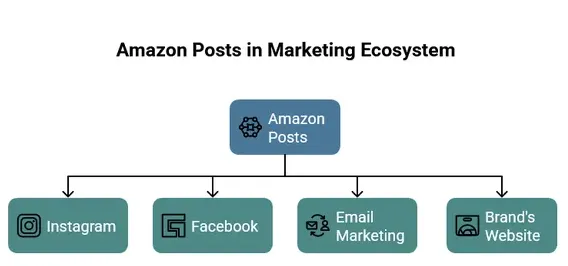
Driving External Traffic to Amazon with Posts Strategy
While Posts primarily live within Amazon, you can leverage them externally:
- Share screenshots of your Posts on social media
- Include “As seen in our Amazon Posts” in email marketing
- Create QR codes linking directly to your Amazon Posts feed
- Reference specific Posts in your off-Amazon advertising
This cross-promotion strengthens your overall marketing impact while driving more eyeballs to your Posts.
Case Studies: Successful Amazon Posts Campaigns
Case Study: Seasonal Strategy That Drove 45% More Holiday Sales
A home décor brand implemented a strategic Posts campaign for the holiday season:
- Created a series of 12 themed Posts showing products in festive settings
- Posted consistently 3 times weekly from October through December
- Used a mix of lifestyle imagery and styled product shots
- Incorporated seasonal keywords naturally in captions
- Tagged complementary products to encourage multiple purchases
The results were impressive:
- 45% increase in seasonal product sales compared to previous year
- 28% higher click-through rate than their standard Posts
- 3.2x more branded searches during the campaign period
- Significant spillover sales to non-seasonal products
The key takeaway was the power of thematic consistency combined with strategic timing.
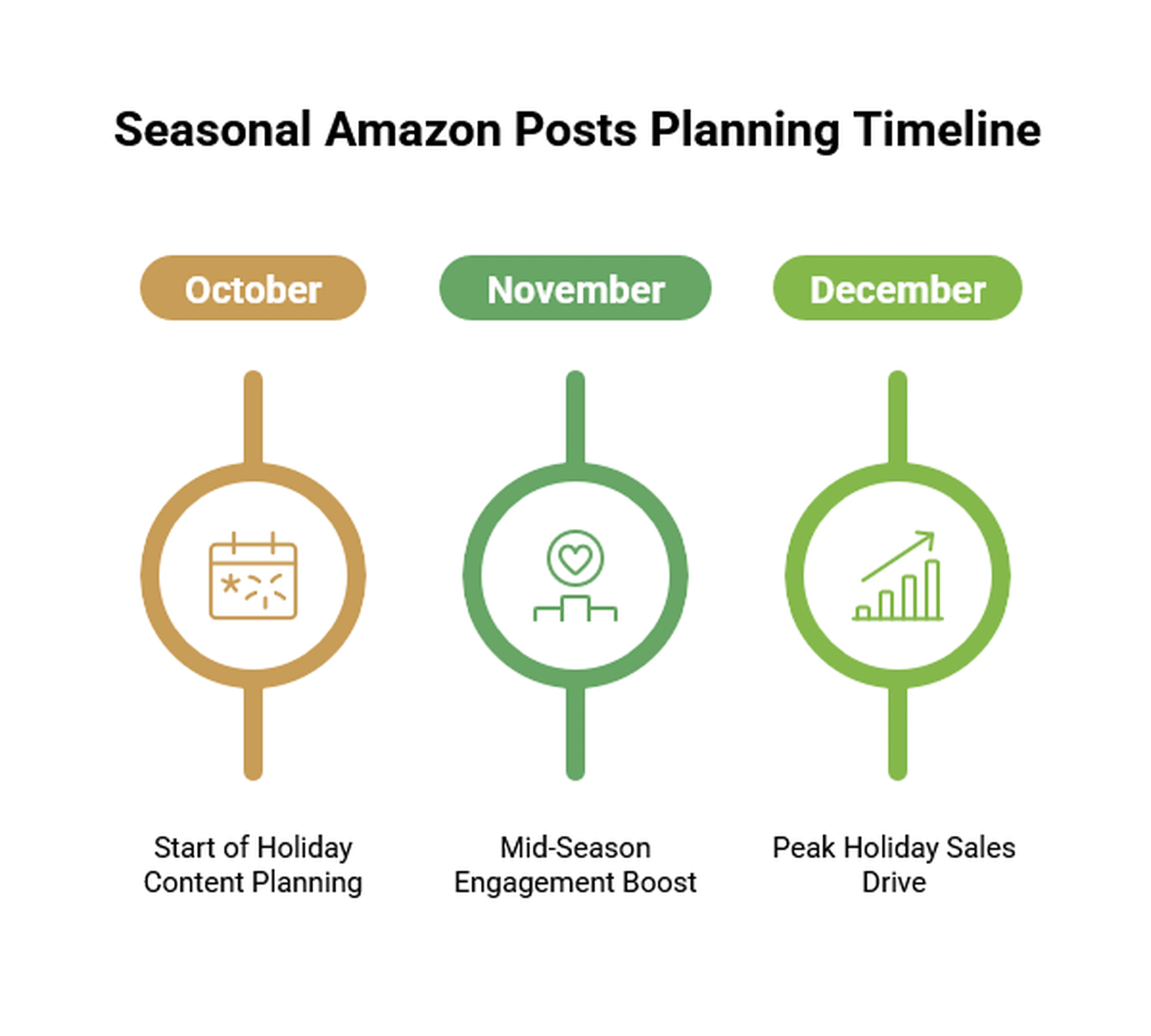
Case Study: New Product Launch Amplified with Posts
A beauty brand used Posts as a central element of their new product launch:
- Created a series of “coming soon” teaser Posts two weeks before launch
- Revealed product benefits gradually across multiple Posts
- Showcased before/after results with real customers
- Highlighted unique selling points through close-up imagery
- Tagged both the new product and complementary existing products
The campaign resulted in:
- 32% higher first-month sales compared to previous product launches
- 52% increase in brand page visits
- Significant cross-selling to complementary products
- Higher organic ranking achieved in half the usual time
This case demonstrates how Posts can accelerate the typical new product ramp-up period on Amazon.
Troubleshooting and Common Challenges
Even experienced sellers encounter challenges with Amazon Posts. Here’s how to overcome the most common issues:
Why Some Posts Underperform and How to Fix Them
If your Posts aren’t generating expected engagement, check for these common problems:
- Images lack visual appeal or professional quality
- Captions are too promotional rather than informative
- Products tagged aren’t relevant to the image content
- Posting frequency is too low to build momentum
- Category tagging isn’t optimized for visibility
The fix is usually found in returning to fundamentals: high-quality imagery, benefit-focused captions, and strategic product tagging.
Dealing with Posts Approval Issues
Amazon has specific guidelines for Posts content. If you’re facing rejection:
- Ensure images don’t contain text overlays or watermarks
- Remove any pricing information or promotional language
- Check that lifestyle images show products in actual use
- Verify that no comparative claims are made about competitors
- Confirm images don’t contain before/after representations for certain categories
When in doubt, err on the side of subtlety—Posts that focus on lifestyle and subtle product benefits typically sail through approval.
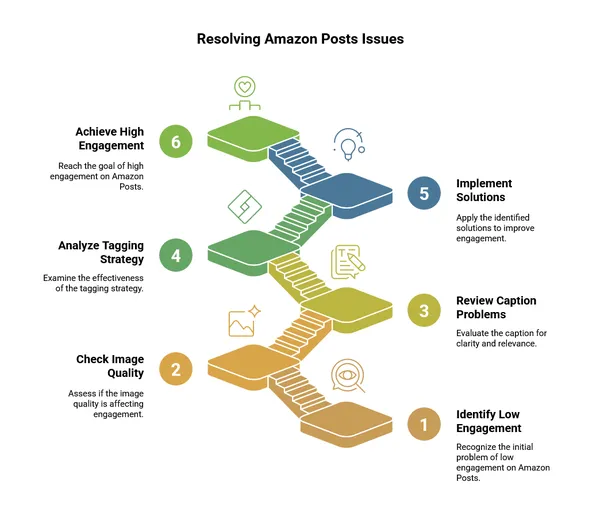
Future-Proofing Your Amazon Posts Strategy
Amazon continues to evolve its Posts feature. Stay ahead with these forward-looking strategies:
Upcoming Amazon Posts Features and How to Leverage Them
Based on Amazon’s pattern of feature development, we anticipate:
- Enhanced analytics with more direct sales attribution
- Expanded placement opportunities across Amazon
- Potential for video content in Posts
- More interactive elements for shopper engagement
- Possible paid boosting options for increased visibility
The sellers who experiment early with new features typically gain competitive advantages before these features become widely adopted.
Building a Sustainable Posts Strategy for Long-Term Growth
Rather than treating Posts as a short-term tactic, build a sustainable approach:
- Develop systems for consistent content creation
- Create templates that can be easily adapted for new products
- Build a library of high-quality lifestyle imagery
- Document what works for your specific brand and products
- Train team members on Posts best practices
This infrastructure approach ensures Posts becomes an ongoing sales driver rather than a sporadic marketing activity.
Implementing Your Amazon Posts Sales Strategy
To turn this knowledge into actual sales results, follow this implementation plan:
Immediate Action Steps
- Audit your current Posts strategy (or create one if you haven’t started)
- Schedule a product photoshoot specifically for Posts content
- Create a content calendar for the next 30 days
- Set up tracking to measure Posts performance
- Identify 3-5 products to prioritize in your initial Posts
30-60-90 Day Implementation Plan
First 30 Days:
- Create and publish 6-8 initial Posts
- Establish baseline metrics
- Test 2-3 different image styles
- Experiment with caption approaches
Days 31-60:
- Analyze initial performance data
- Refine strategy based on early results
- Increase posting frequency if results are positive
- Begin A/B testing specific elements
Days 61-90:
- Scale successful approaches
- Integrate Posts strategy with other marketing channels
- Develop advanced analytics tracking
- Train additional team members on Posts creation
The key to success is consistent implementation combined with data-driven optimization. Start small, measure carefully, and scale what works.
By implementing these strategies, you’ll be well-positioned to leverage Amazon Posts as a significant sales driver for your brand—often outperforming more expensive marketing channels in terms of ROI and customer engagement.
Bonus Section: Expert Template Library
To help you get started immediately, here are proven templates for effective Amazon Posts:
Caption Formula for Product Benefits
“[Relatable problem/situation]? Our [product name] [key benefit]. With [unique feature], you’ll [specific outcome]. Perfect for [ideal user] who [common pain point]. Tap to discover how it can [primary benefit].”
Example: “Struggling with frizzy hair in humid weather? Our Silk Smooth Serum tames even the most unruly locks. With argan oil and keratin infusion, you’ll enjoy salon-quality smoothness for up to 72 hours. Perfect for busy professionals who don’t have time for constant touch-ups. Tap to discover how it can transform your hair care routine.”
Caption Formula for Seasonal Relevance
“[Season/holiday] is the perfect time to [seasonal activity]. Our [product] helps you [seasonal benefit] without [common seasonal challenge]. Discover why [customer type] choose [product name] for their [seasonal need].”
Example: “Summer is the perfect time for outdoor adventures. Our UltraLight Backpack helps you carry all your essentials without weighing you down in the heat. Discover why serious hikers choose TrekPro for their warm-weather expeditions.”
Content Calendar Template
To maintain consistency, use this simplified 4-week content calendar approach:
Week 1:
- Monday: Lifestyle Post showing primary product in use
- Thursday: Educational Post explaining key benefit
Week 2:
- Tuesday: Customer testimonial or review highlight
- Friday: Product feature spotlight
Week 3:
- Monday: Complementary products Post (cross-selling opportunity)
- Thursday: Problem-solution Post addressing customer pain point
Week 4:
- Tuesday: Seasonal or trending topic Post
- Friday: Behind-the-scenes or brand story Post
This rotation ensures variety while maintaining a consistent posting schedule that covers all major Post types that drive engagement and sales.
Remember, the key to Amazon Posts success isn’t just creating great content—it’s creating strategic content that drives shoppers to purchase. By implementing these templates and strategies, you’ll be well ahead of most sellers who either ignore Posts entirely or use them ineffectively.
The brands that master Amazon Posts now will have a significant competitive advantage as Amazon continues to expand this feature’s prominence in the shopping experience. Will your brand be one of them?